Review and photographs by Funk, edited by Suspsy
Ever since I first saw preview pictures of the stop motion figures used to animate the dinosaurs in the 1994 Atari fighting game Primal Rage in a Nintendo magazine, I thought, “wow, they would make great toys.” Fast forward to a few years ago where I learned such toys were actually produced by Playmates of Teenage Mutant Ninja Turtles fame, and I got a few of them used. My favourite character in the game, and the one reviewed here, was Talon, whose taxonomic identity was only given as “great chief of the Raptor Clan” in the game’s manual. He is obviously a dromaeosaur of some kind, probably inspired by the Deinonychus-based Velociraptors that became famous the year before in Jurassic Park. Unlike the other characters, his main attack moves featured his claws, which was fitting for a dromaeosaur. The dinosaurs (and apes) in this game were sort of oversized Kaiju-gods, which awoke to conquer the world by fighting each other and eating tiny humans.
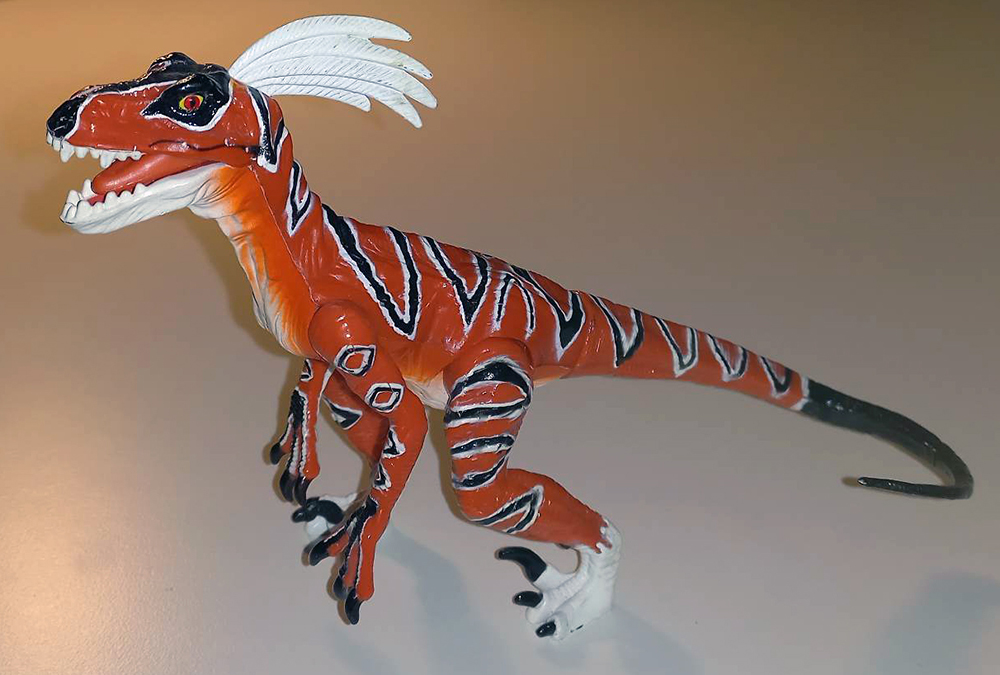
First off, one of the most notable features of the Talon character, and carried over to the toy, is a crest of feathers on the head. While this may not make it the first non-avian dinosaur toy with feathers, an award that would go to Tyco’s 1989 Dino-Riders Struthiomimus (which had its feathers smoothed away in later releases, the version reviewed here on the blog), it may be the first dromaeosaur toy with feathers. While the Primal Rage game is from 1994, the toy line came out in 1996, so there may be earlier contenders for feathered figures; feel free to point them out in the comments if that’s the case. Kenner’s 1998 Velociraptoryx is another early attempt, though a hybrid.
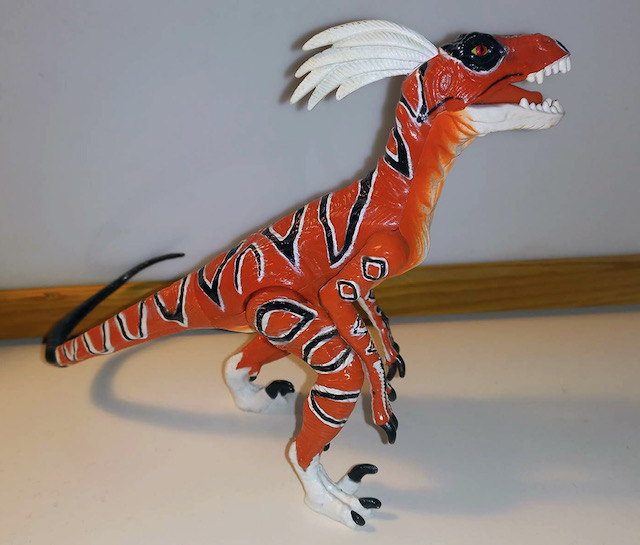
The mohawk-crested dromaeosaur meme warrants some discussion as well. While dromaeosaurs were depicted with feathers and head crests as far back as the 80s by artists such as Gregory S. Paul and Luis V. Rey (with the first feathered non-avian taxon being a crested Syntarsus depicted by Sarah B. Landry in 1975), there seems to have been a middle ground in the 90s for artists who weren’t entirely ready to go fully feathered, and instead stuck with scaly bodies combined with crested heads. The first design I know of in this style was Quetzal the Deinonychus in the 1993 comic Age of Reptiles by Ricardo Delgado, which may be the inspiration for Talon (similar colour scheme too), and then there’s Wayne Barlowe’s 1995 Velociraptor, which is too late to have been an influence, though I long thought it was. The Velociraptors from 2001’s Jurassic Park III are of course latecomers to this trend.

Back to the Talon toy in particular, the crest is one of various ways it differs from the game design in that the feathers seem to attach as a closely clustered tuft at the back of the head instead of as separate feathers running from the head and across the back of the neck. The individual feathers also seem proportionally far longer, and to have more defined barbs. While I like the game’s design more, perhaps there is some practical reason for having the feathers packed together as one piece of plastic, and they’re probably less likely to fall out. The feathers are white in both versions, though more yellowish in the game.

The head differs in that the eyes are much smaller in the toy than in the game, and the snout has a less concave profile, which I don’t see much logical reason for. Unfortunately, the head looks quite asymmetrical when seen from the front (with the jaw skewed to the left), and it appears that this is an issue for all copies of the figure. Apart from this, the proportions of the toy seem to match those of the game character overall, being those of a generic, unfeathered 90s dromaeosaur. The figure is about 22 cm long from the snout to the hind margin of the forward curved tail, and when in a horizontal pose, it’s about 13 cm tall at the head.
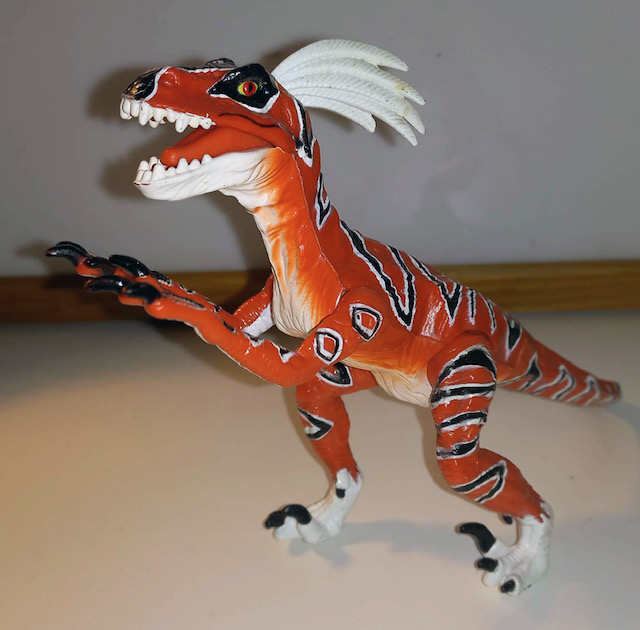
While the toy keeps the red, black, and white colour scheme of the game, the black stripes have white outlines that I don’t seem to recognise in the game (see this close up from the game’s “Making of” doc), but it does resemble some promo images from the time. The claws are also black in the toy, while they’re yellowish in the game. A minor point is that while the underside of the figure is white, this stops abruptly by the base of the tail joint instead of continuing on the underside of the tail, which looks unnatural. The figure also exists in at least an alternate yellow version.
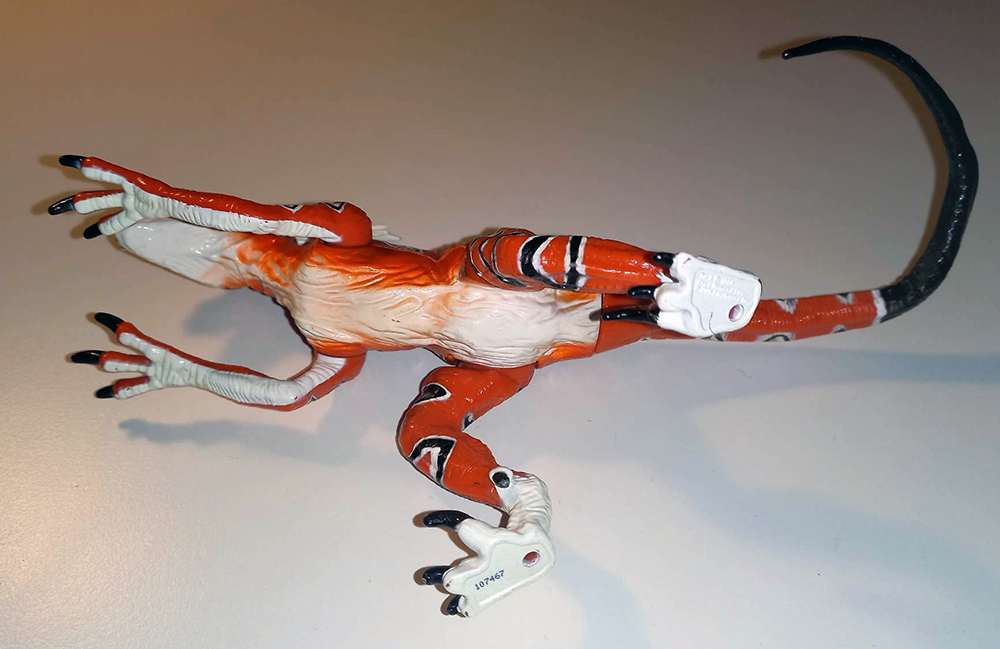
Action-wise, the toy has arms and legs that can be rotated in unison, but this is mainly to put the arms in a locked position so that they can slash downwards when the legs are pulled back. This of course makes it generally hard to pose the limbs as one wishes, and since the legs have to lock into a position, it is also quite difficult to get the toy to stand on its own. I guess that’s where the rotating tail comes in, but when turning the tip down to act as a tripod, the stripes on the upper side of the tail are moved to the side, and it becomes very obvious that this is not their intended position. The toy originally came with red, bladed “gloves” and “boots,” but I’m kind of happy I didn’t get them with my figure, as they look ridiculous, and were not in the game.
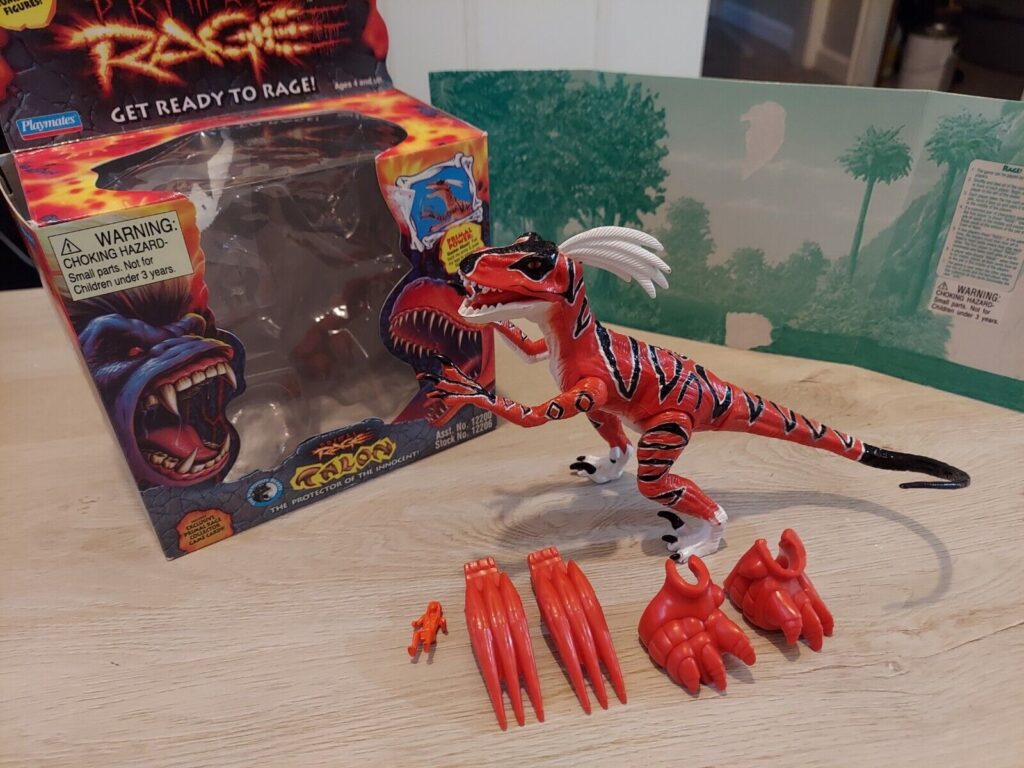
All in all, it’s a pretty cool toy for historical reasons, being one of the earliest feathered non-avian dinosaur toys, if not the earliest feathered dromaeosaur toy, and along with the rest of the Primal Rage line, among the few dinosaurs from games that have been made into toys. While I wish it looked more like the game’s character in the head area, it is overall recognisable due to the colour scheme and crest. I also wish the limbs had been individually mobile and that the jaws could have moved, but I guess all design energy went into the arm slashing mechanism. Used figures seem to be widely available and rather cheap. As a side note, shortly after I received this figure, I noticed it in the 1997 film As Good as it Gets, where the Helen Hunt character’s kid holds it in a shot at 47:16 in.
Disclaimer: links to Ebay and Amazon on the DinoToyBlog are affiliate links, so we make a small commission if you use them. Thanks for supporting us!




I’m pretty sure every one of us has owned one of these at some point in our lives, even when we weren’t looking for it. Thank you for the review. I’m glad to see someone else pointing out the whole thing with the jaws. I thought there was something wrong with mine until more ended up in my house.
Great to see a review of this guy on the blog here finally. I wanted to do it back when I got the figure in 2021, but never got around to it, because I just didn’t have the energy for it sadly. I think this character is the reason why I was so accepting to learning about dromaeosaurids being feathered in real life. Of course it wasn’t fully feathered, but it was a mere taste. It almost parallels the male JPIII raptors in a way, that came much later.
I went through most of my childhood completely oblivious to this game’s existence, up until I started finding fanart of it online. Talon looks like a fun toy to own (and for beating up Hasbro and Chap Mei dinos); it’s also a neat reminder how long the concepts and attempts at feathered dinosaurs have really been around!
Nice to finally have another Primal Rage toy on the blog. This review was tagged as Deinonychus because Talon was identified as such in the official PR strategy guide, which I owned back in the day. Also says so on the PR wiki.
Thanks, I thought someone had just made it up on the Wiki…
For the official record, Sauron is a T. rex. Diablo is an Allosaurus despite his T. rex hands. Vertigo is an Efraasia despite clearly being based on a cobra. Blizzard and Chaos are both “Kong.” And Armadon is a “Tristegosaurotops.”
Good to know, Armadon is next! I always thought Vertigo was supposed to be some kind of JP style Dilophosaurus, Efraasia, huh…